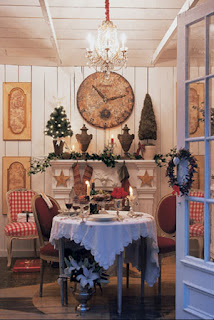 photo: www.fjorn.com
photo: www.fjorn.com.jpg) Inspired by Aina's beautiful site, Modern Country, I have decided to write about a Scandinavian Christmas...as it is a style that I know appeals to so many of us. The pleasing mix of creams, whites, silver, gold and reds offers such a clean approach to holiday decorating. It feels fresh, yet comfortable in a way that simply modern style can struggle with. Scandinavia is comprised of Denmark, Norway and Sweden (and usually Finland and Iceland) and thus has a wonderful European flair intertwined with deep-rooted history. There is a definite focus on nature and the use of greenery, candle light and handmade treasures. Where it differs from homespun decorating is, again, the use of light colours and keeping accessories to a minimum.
Inspired by Aina's beautiful site, Modern Country, I have decided to write about a Scandinavian Christmas...as it is a style that I know appeals to so many of us. The pleasing mix of creams, whites, silver, gold and reds offers such a clean approach to holiday decorating. It feels fresh, yet comfortable in a way that simply modern style can struggle with. Scandinavia is comprised of Denmark, Norway and Sweden (and usually Finland and Iceland) and thus has a wonderful European flair intertwined with deep-rooted history. There is a definite focus on nature and the use of greenery, candle light and handmade treasures. Where it differs from homespun decorating is, again, the use of light colours and keeping accessories to a minimum.Simplicity is the key to carrying off a true Scandinavian decor scheme...nothing too flashy or glitzy...and certainly no competitions between neighbours to see whose house can bear the most Christmas lights!!

Christmas in Norway, Aina shares, is a wonderful celebration with a few twists on tradition as compared to Christmas in North America. The Christmas tree (usually a real one) is decorated on December 23rd. According to the website: http://www.msl.no/jul_eng_oversikt.htm, electric candlelights, and small norwegian flagsadd to the other tree decorations. The presents are placed under the tree and
 stockings are filled that same evening. On Christmas Eve at lunchtime, a meal consisting of rice pudding or porridge is served and an almond is hidden within. The lucky finder of the almond wins a pig made of almond paste. According to Aina, Norwegian families dance or walk around the Christmas tree singing Christmas carols. Families then bundle themselves off to church for a 4pm service, and at 5pm all churchbells in Norway are chiming for "Christmas Peace".. Following church services, a large meal, extending well into the late evening is enjoyed followed by the children opening their gifts while the adults relax, chat, drink coffee and eat sweets. The Peace of Christmas has thus arrived...
stockings are filled that same evening. On Christmas Eve at lunchtime, a meal consisting of rice pudding or porridge is served and an almond is hidden within. The lucky finder of the almond wins a pig made of almond paste. According to Aina, Norwegian families dance or walk around the Christmas tree singing Christmas carols. Families then bundle themselves off to church for a 4pm service, and at 5pm all churchbells in Norway are chiming for "Christmas Peace".. Following church services, a large meal, extending well into the late evening is enjoyed followed by the children opening their gifts while the adults relax, chat, drink coffee and eat sweets. The Peace of Christmas has thus arrived... angel photo and large tree: www.vakrehjem.com
angel photo and large tree: www.vakrehjem.comstraw horses: http://www.hemslojd.com/


photo: www.styleathome.com
" In Scandinavia, a Pixie or Nisse is a household spirit that is responsible for the care and prosperity of a farm or family. A Nisse is usually described as a short man or woman (under four feet tall) wearing a red cap. While belief in guardian spirits is a very old tradition in Scandinavia, belief in Nisser was prominent in the late eighteenth and nineteenth centuries in Denmark, southern Norway and southern Sweden. Many farms claimed to have their own Nisse. The Nisse took an active interest in the farm by performing chores such as grooming horses, carrying bales of hay, and other farm-related tasks. These chores were usually done much more efficiently and effectively than by their human counterparts.However, Nisser could be temperamental, to say the least. If the household was not careful to keep its Nisse satisfied -- usually in the form of a single bowl of porridge with butter in it left out on Christmas Eve -- the spirit could turn against its masters.In the 1840s the farm's Nisse became the bearer of Christmas presents in Scandinavia, and was then called "Julenisse" and has been associated with Christmas ever since.
In Scandinavia, a Pixie or Nisse is a household spirit that is responsible for the care and prosperity of a farm or family. A Nisse is usually described as a short man or woman (under four feet tall) wearing a red cap. While belief in guardian spirits is a very old tradition in Scandinavia, belief in Nisser was prominent in the late eighteenth and nineteenth centuries in Denmark, southern Norway and southern Sweden. Many farms claimed to have their own Nisse. The Nisse took an active interest in the farm by performing chores such as grooming horses, carrying bales of hay, and other farm-related tasks. These chores were usually done much more efficiently and effectively than by their human counterparts.However, Nisser could be temperamental, to say the least. If the household was not careful to keep its Nisse satisfied -- usually in the form of a single bowl of porridge with butter in it left out on Christmas Eve -- the spirit could turn against its masters.In the 1840s the farm's Nisse became the bearer of Christmas presents in Scandinavia, and was then called "Julenisse" and has been associated with Christmas ever since. " (info source: http://www.msl.no/jul_eng_oversikt.htm)
" (info source: http://www.msl.no/jul_eng_oversikt.htm)



0 comments:
Post a Comment